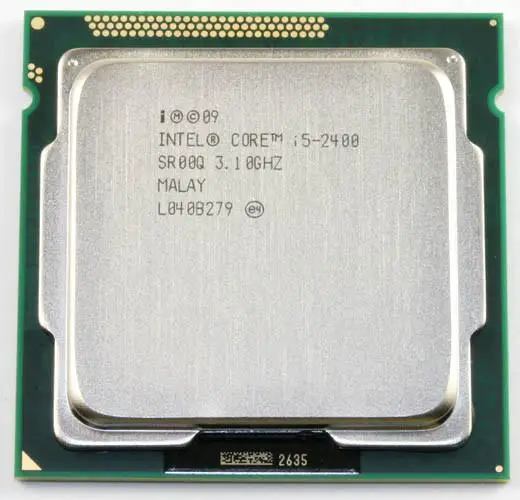Driver Intel Core I5 2400 Reviews
Intel's first 22nm CPU, codenamed Ivy Bridge, is off to an odd start. Intel unveiled many of the quad-core and last month, but. Are announced today, as are their ultra-low-voltage counterparts for use in Ultrabooks. One dual-core desktop part gets announced today as well, but the bulk of the dual-core lineup won't surface until later this year. Furthermore, Intel only revealed the die size and transistor count of a single configuration: a quad-core with GT2 graphics.Compare this to the Sandy Bridge launch a year prior where Intel sampled four different CPUs and gave us a detailed breakdown of die size and transistor counts for quad-core, dual-core and GT1/GT2 configurations.
Why the change? Various sects within Intel management have different feelings on how much or how little information should be shared. It's also true that at the highest levels there's a bit of paranoia about the threat ARM poses to Intel in the long run. Combine the two and you can see how some folks at Intel might feel it's better to behave a bit more guarded. I don't agree, but this is the hand we've been dealt.Intel also introduced a new part into the Ivy Bridge lineup while we weren't looking: the Core i5-3470. At the Ivy Bridge launch we were told about a Core i5-3450, a quad-core CPU clocked at 3.1GHz with Intel's HD 2500 graphics.
The 3470 is near identical, but runs 100MHz faster. We're often hard on AMD for introducing SKUs separated by only 100MHz and a handful of dollars, so it's worth pointing out that Intel is doing the exact same here. It's possible that 22nm yields are doing better than expected and the 3470 will simply quickly take the place of the 3450. Thursday, May 31, 2012 - If a Cortex-A15 would give you enough computing power, you should also be happy with a Pentium or even a Celeron. The i3 is already rather overkill for a simple NAS.I have a fileserver with Windows Server Home running on a Pentium G620, and it has absolutely no problem to push 120 MB/s over a GBit Ethernet switch from a RAID-0 pack of HDDs while running µtorrent, Thunderbird, Miranda and Firefox on the side. Power consumption of the complete system is around 40-50W in idle, and I havn't even shopped for specifically low-power components but used a lot of leftovers.
The big news about the first Ivy Bridge processors was the improved graphics, but with this second tier iGPU, can the Core i5 3470 match the pace of its technological compatriots?With the i5 tag, it's a non-Hyperthreaded chip of the straight quad-core ilk, and sitting beneath the Intel means it comes with a lower starting clockspeed of 3.2GHz. The missing 'K' from its name shows up the lack of overclocking potential from the Ivy Bridge architecture.That's a shame, as the other IvB chips we've played with have overclocked as well as their Sandy Bridge elders. But if overclocking's not your bag then grabbing a cheaper quad-core with the latest Intel architecture should be the sensible choice. Right?Shader-lightIf the Intel Core i5 3470 wasn't pared back enough (with the removal of Hyperthreading and overclocking for marketing reasons), consider that this Ivy Bridge CPU is also sporting the weaker of Intel's graphics parts.In this chip we're looking at the Intel HD 2500 graphics versus the HD 4000 of the top Core i5 3570K and i7 3770K parts. That means a woeful six unified shaders compared with the generally inadequate 16 shaders of the HD 4000 core. If you're after the CPU graphics to deliver gaming performance, you'll be sorely disappointed.While the HD 4000 does give some little hope of gaming frame rates - we were playing Batman: Arkham City at 1080p on the lowest settings at nearly 30fps - the slashing of constituent graphical components from the HD 2500 core means you've got little to no hope with it.But you wouldn't expect processor graphics to offer gaming speed, and most of us are fully paid up members of the discrete graphics club.
So what does it mean for the likes of QuickSync on this lower-end CPU?The bad news is that there is some drop off in performance. The good news is that it's fairly negligible. Our MediaEspresso encoding benchmark took only 25s compared with the 23s for the HD 4000 series.What about straight-line performance? At stock speeds it actually stands up against the i5 3570K, turbo-ing at 3.62GHz versus 3.82GHz. But that's where the K series chip's ease of overclocking comes to the fore.
You can easily up the multiplier to 45-46 and hit crazy frequencies right away. The Intel Core i5 3470 though is limited to a multiplier of 38 for all cores, allowing it to go up to 40 for single core operation.
That nominally means a limit of 3.8GHz. BenchmarksRendering performanceCinebench 11.5: Index score: Higher is betterINTEL CORE I5 3470: 6.01INTEL CORE I5 3570K: 6.33INTEL CORE I7 3770K: 7.91Video encodingShogun: FPS: Higher is betterINTEL CORE I5 3470: 36.44INTEL CORE I5 3570K: 38.46INTEL CORE I7 3770K: 39.07QuickSync performanceMediaEspresso: Time in seconds: Quicker is betterINTEL CORE I5 3470: 25INTEL CORE I5 3570K: 23That said, we managed to hit 3.99GHz with a little sprinkling of the baseclock overclocking that Ivy Bridge now allows.
Driver Intel Core I5 2400 Reviews And Ratings
That sort of performance should make this chip a more compelling proposition.It must be much cheaper, right? Well, there lies the rub.

Raseone font family. This chunk of hobbled silicon is barely £15 less than the awesome Intel Core i5 3570K. There is no reason we can think of to recommend anyone buy this chip over the top-end CPU.
If you can't afford the extra £15, save for a couple weeks and just man up.